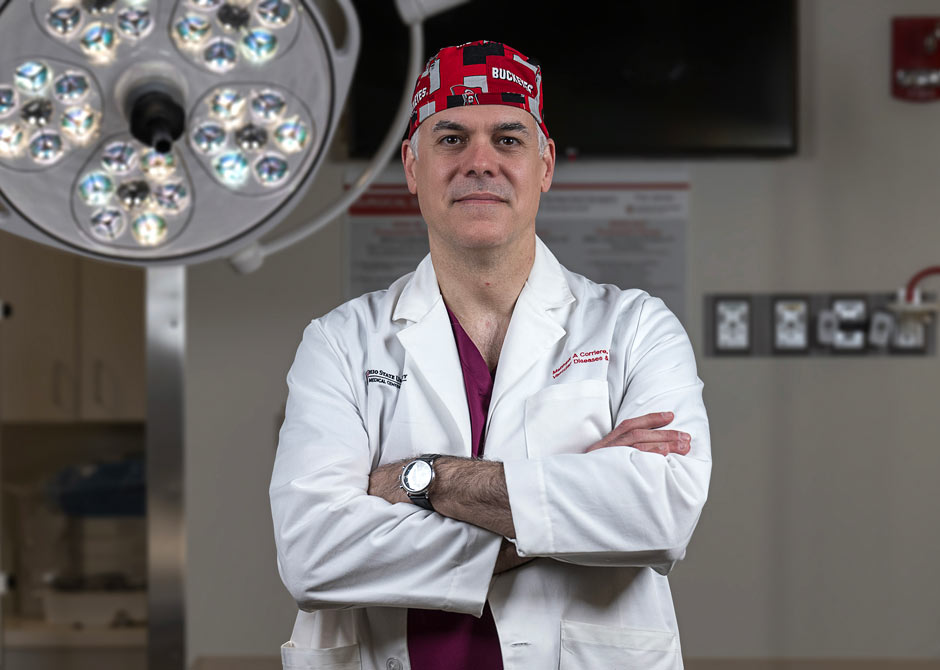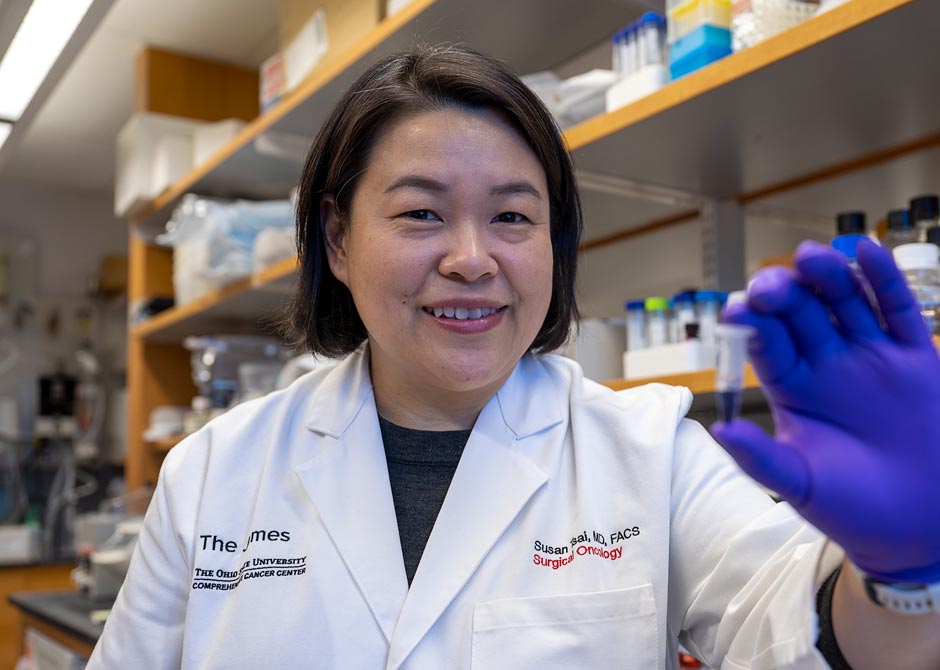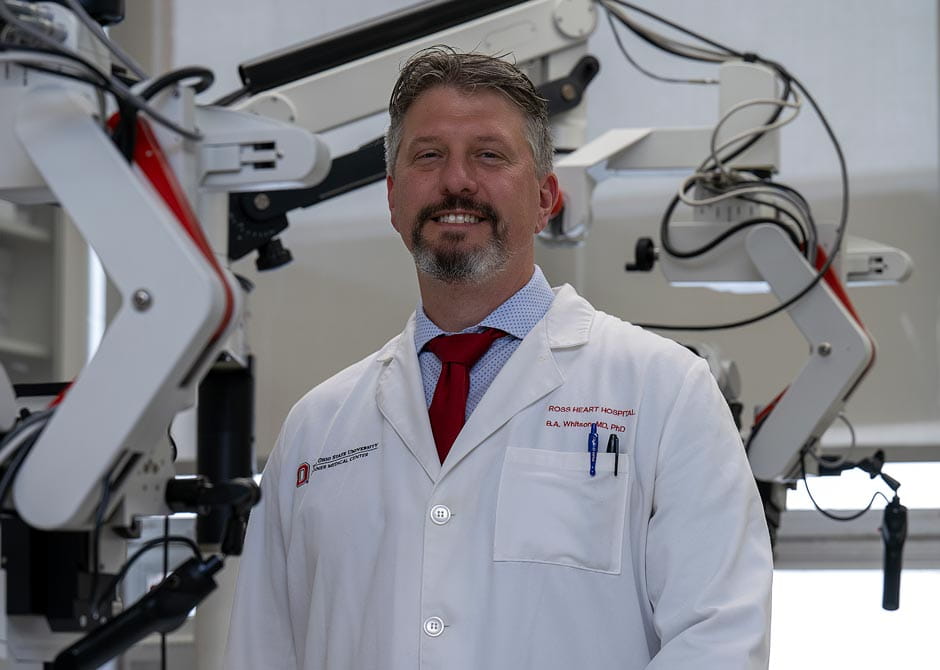The Ohio State University College of Medicine’s Department of Surgery welcomed three new division directors in 2024. They’re poised to inspire and lead our surgeons to new levels of success and innovation. And they’re each ready to create their own story at Ohio State.
Matthew Corriere, MD: Leading the Way in Vascular Surgery
 Joining us as the director of the Division of Vascular Surgery, Matthew Corriere, MD, brings a remarkable background in vascular health and innovation to the Department of Surgery. Dr. Corriere’s previous tenure at the University of Michigan saw him contribute significantly to vascular surgical education and patient care. His research in clinical outcomes set new benchmarks in the field.
Joining us as the director of the Division of Vascular Surgery, Matthew Corriere, MD, brings a remarkable background in vascular health and innovation to the Department of Surgery. Dr. Corriere’s previous tenure at the University of Michigan saw him contribute significantly to vascular surgical education and patient care. His research in clinical outcomes set new benchmarks in the field.
Dr. Corriere hadn’t planned on being a surgeon, but thankfully, during his vascular surgery rotation in medical school, he found the work incredibly interesting and impactful.
“I love how vascular surgeons blend expertise in diagnosis, medical management and imaging with a wide variety of procedural techniques. The rewards of vascular surgery more than justify the demands,” he says.
He went on to complete his residency in general surgery at Vanderbilt University School of Medicine and a fellowship in vascular surgery at Wake Forest University School of Medicine.
Dr. Corriere is now improving vascular health through evidence-based practices and innovative research projects. Inspired by the faculty at Ohio State and its commitment to advancements in patient care and research, he brought his expertise and leadership to the Division of Vascular Surgery.
“Even before I came to Ohio State, I admired their vision of clinical excellence, and I’m thrilled that I now get to pursue that with the team daily.
“I believe our division is poised to become truly elite,” Dr. Corriere says. “I am thrilled to be here at such an exciting time and look forward to amplifying the visibility of our group and the amazing work we are doing together.”
We believe that his elite leadership will inspire many more stories of success in vascular surgery.
Susan Tsai, MD, MHS: A Visionary in Surgical Oncology
 We’re thrilled to welcome Susan Tsai, MD, MHS, as the new director of the Division of Surgical Oncology. Dr. Tsai’s journey to Ohio State is marked by exemplary leadership and groundbreaking research, particularly in pancreatic cancer.
We’re thrilled to welcome Susan Tsai, MD, MHS, as the new director of the Division of Surgical Oncology. Dr. Tsai’s journey to Ohio State is marked by exemplary leadership and groundbreaking research, particularly in pancreatic cancer.
“Surgical oncology fascinated me because it blends science, compassion and advocacy,” she says. “Working with patients with cancer, I appreciated how surgery fits within a multidisciplinary care model – coordinating with medical oncologists, radiologists and researchers to craft personalized care plans. We are living through an exciting time in oncology with the expansion of precision medicine and immuno-oncology. Now more than ever, patients with cancer have hope.”
This multidisciplinary approach is one aspect that drew her to Ohio State.
“I’ve always been passionate about accelerating the delivery of state-of-the-art scientific advancements to patients, and Ohio State’s comprehensive cancer program – with its focus on multidisciplinary collaboration and translational research – felt like the ideal place to advance that mission,” Dr. Tsai says. “The integration of research, patient care and education creates an environment where I feel empowered to make a meaningful difference – not only in the operating room but also through mentorship and community impact.”
Dr. Tsai comes to the Department of Surgery from the Medical College of Wisconsin, where she was an endowed professor and led the LaBahn Pancreatic Cancer Program and the gastrointestinal cancer disease-oriented team for the Medical College of Wisconsin Cancer Center. She directed a multidisciplinary team to advance clinical and translational research.
Her expertise in blood-based biomarkers and precision medicine has earned her NIH funding and key roles in prominent research projects. Dr. Tsai’s academic path began at MIT, followed by medical school and residency at the University of Michigan and specialized training at Johns Hopkins. We’re eager to see how she’ll continue to craft her story here at Ohio State, guiding new generations of surgeons.
Bryan Whitson, MD, PhD: Pioneering Advances in Cardiac Surgery
 We’re equally excited to announce Bryan Whitson, MD, PhD, as the new director of the Division of Cardiac Surgery. With his incredible background in cardiothoracic surgery, Dr. Whitson has been making significant strides in both clinical and academic arenas at Ohio State for more than 12 years.
We’re equally excited to announce Bryan Whitson, MD, PhD, as the new director of the Division of Cardiac Surgery. With his incredible background in cardiothoracic surgery, Dr. Whitson has been making significant strides in both clinical and academic arenas at Ohio State for more than 12 years.
“I wanted to become a surgeon-scientist because, as a trainee and young physician, I recognized that this blend had the greatest potential for positive patient impact,” Dr. Whitson says. “By developing cutting-edge technologies and implementing them directly in clinical care, we can address the surgical needs of patients more effectively.”
And he’s doing just that. The NIH-funded surgeon-scientist is currently the vice chair for Innovation and Translational Research in the Department of Surgery and co-director of COPPER Laboratory. Dr. Whitson oversees a robust and diverse faculty of scientists, surgeon-scientists and surgeons who conduct tremendous breadth of research within the Division of Cardiac Surgery across discovery science, translational science, implementation science and clinical trial portfolios. The team is actively working on treatments that target cells to reduce damage caused by restricted blood flow and to keep the heart, lungs and blood vessels healthy as diseases progress or are treated.
“With our current research and robust clinical trials portfolio in the Division, we are not only enhancing the quality of life for our patients but also paving the way for future innovations in cardiovascular care,” he says. “This research is a testament to our commitment to pushing the boundaries of medical science and delivering the best possible care to our patients.”
Dr. Whitson also oversees the Ohio State Heart and Vascular Center as interim co-director. After he received his medical degree from Indiana University, he went on to the University of Minnesota, where he completed his general surgery and cardiothoracic surgery training, as well as a clinical fellowship in surgical infectious diseases. He also received a doctoral degree from the University of Minnesota.
